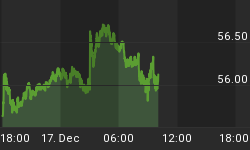The Fed raises its fed funds rate by 25 bps to 4.75%, and issued a more upbeat policy statement, sparking renewed rally in the dollar. The decision has erased all of the dollar's losses that emerged after the higher than expected increase in Germany's IFO survey earlier today. The Fed's hawkishness is underlined by the fact that it not only has the FOMC stayed away from acknowledging the most notable sign of economic weakness--namely new home sales showing their biggest drop in 9 years and mortgage applications hitting 3-year lows-- but also issued a more upbeat view and description of the economy. The differences are illustrated below:
Mar 27-28 FOMC: The slowing of the growth of real GDP in the fourth quarter of 2005 seems largely to have reflected temporary or special factors. Economic growth has rebounded strongly in the current quarter but appears likely to moderate to a more sustainable pace.
Jan 31 FOMC: Although recent economic data have been uneven, the expansion in economic activity appears solid. Core inflation has stayed relatively low in recent months and longer-term inflation expectations remain contained.
Especially positive for the dollar is that the 10-year yield has kept up with the 25-bp rate hike in the fed funds rate and climbed by 4 bps to 4.78%, suggesting that the fed funds rate has still ground for moving higher. Today's positive Fed rhetoric solidifies the probability for a May rate hike and confirms the dollar's yield superiority to yield-chasing investors, including foreign central banks.
Yield curve reinverts and sparks further dollar rally
The other sign that the market is pricing further tightening is the renewed yield curve inversion as the 10-2 year spread moves to -1 bps from 0 earlier today. The chart shows how the high positive correlation between the yield curve inversion and dollar rallies remains continues to hold. We saw yesterday the dollar rallying across the board and keeping the euro at $1.1980-1.12020 as the 10-2 year yield spread was -4 bps -- in favor of the 2-year yield. Then in early European trade today, we saw the post-IFO rally in the euro further sparked into the US session as the yield curve became normalized, i.e 10-2 year yield spread turned from -3 bps yesterday to 0 bps, suggesting that the market was pricing a declining probability of a May rate hike.

- March 8: Yield curve revisited positive territory and helped the euro start an 8-day gain.
- March 21: Euro intensifies pullback, one day after the yield curve reinverted following Bernanke's bullish speech on yield curves.
- March 28 (pre FOMC): Euro rallied by yield spread rising to zero from -4 bps
- March 28 (post FOMC) yield spread reinverts to -1 bp, after hawkish FOMC statement.
Unlike Schumer-Graham, Grassley-Baucus legislation puts ball in Treasury's court
Another potentially dollar positive development is the postponement of the more targeted legislation bill by Sens Schumer-Graham to slap china with a 27.5% import tariff and the introduction of the less China-specific bill by Sens Charles Grassley and Max Baucus to threaten new sanctions against countries found to have "currency misalignments" with the US.
It is important to note that the Grassley-Baucus is in function of the US Treasury's incoming report on International Economic & Exchange Rate Policies and not in function on Beijing decision to adjust its currency regime in a way that is pleasing to the discretion of US Senators. Thus, with Baucus and Grassley placing the ball in the court of the US Treasury, it is unlikely that the White House, will label China as a currency manipulator during the same week when Chinese president Hui Jintao is due to visit Washington, an action that would defy the basics of international diplomacy.
Flashback to last year, recall that Sens Schumer and Graham threatened to pass their deadline last May only to be assured by Alan Greenspan and pres Bush that China would make an adjustment. Effectively, Beijing did revalue the yuan by 2.1% 2 months before Hu Jintao's visit to Washington.
-
We expect China to announce a minor currency move as early as next month -- 1.8%-2.2% revaluation.
-
While we stick with our 1.18-1.23 3-month outlook range for EURUSD, we expect EURUSD to garner modest upside later in the week as the market begins to adjust for the ECB's expected rate hike on April 6th. Any drop below the 100 day MA of 1.1950 seen stabilizing at 1.19 trend line support, while upside capped at 1.2060.
-
We reiterate our expectations for USDJPY to remain confined in its symmetrical triangle of 118.75-116.25. FOMC-driven dollar bullishness continues to reemerge on the upside while improving Japanese data and creeping expectations of policy tightening act as a drag on the pair.















